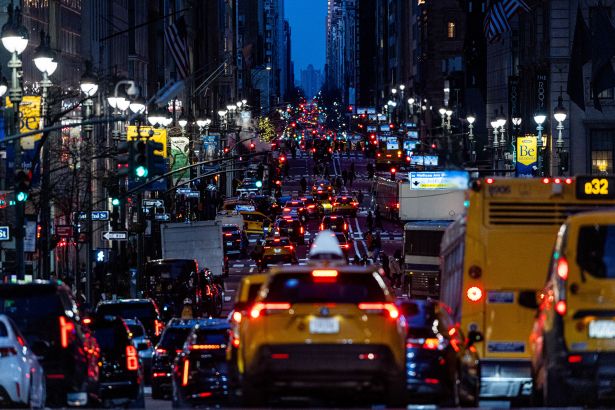Clash Between City, State and Feds Leaves Leadership Vacuum in an Exhausted New York
The elbowing between Trump, Hochul and Adams over the fate of New York City’s mayor has left a leadership vacuum that’s not good for business
By Mark Hallum February 21, 2025 1:28 pm
reprints
Dealings among Gov. Kathy Hochul, Mayor Eric Adams and President Donald Trump were like a venn diagram from hell this last week.
Observers (of the Commercial variety at least) were subject to whiplash as fear, loathing and retribution festooned the executive chambers of the three levels of government, resulting in a begrudging peace as Friday approached — and not soon enough.
In the end, Adams defied the odds by keeping his job while Hochul and the Trump administration plan to let a judge settle the score on whether congestion pricing in Manhattan will live and whether the very operations of the city that so much of its commerce depends on will run smoothly.
And, if correlation equals causation, the theory that Trump has been attempting to hold Adams and Hochul hostage might have legs.
For Hochul, there was the desire to preserve the controversial congestion pricing toll into central Manhattan, a topic on which Trump has held discussions with the governor since taking office last month.

For Trump, his alliance with Adams seemed to be a priority, as the president has done everything in his power to dissolve the federal corruption charges hanging over the embattled mayor’s head. However, the feds dismissed the case “without prejudice,” meaning it could be reopened in the future, leading some to worry Trump could use that as leverage to keep Adams in line.
With Hochul having the executive authority to remove Adams from office, actions from the White House seemed to be the only thing stopping her apart from clearly wanting to give Adams the opportunity to govern properly before an election could be held.
Adams has denied any quid pro quo, rejecting claims that Trump’s Justice Department dropped the federal charges in exchange for his cooperation with Immigration and U.S. Customs Enforcement. So has Trump’s border czar, Tom Homan, who nevertheless seemed to allude to an advantageous mutual agreement by saying on national television that if Adams “doesn’t come through … I’ll be in his office, up his butt, saying, ‘Where the hell is this agreement we came to?’”
Adams said Feb. 20 that Homan later apologized for fueling the perception that the charges were dropped in exchange for political favors, with both denying an arrangement.
“[Homan] spoke with me, [he said], you know, ‘Eric, we’re on TV. I should not have said that. I apologize to you,’” Adams said in an interview with NY1’s “Inside City Hall.”
Further doubt accumulated as four of Adams’s deputy mayors announced their resignations last week.
Maria Torres-Springer (first deputy), Anne Williams-Isom (health and human services), Meera Joshi (operations) and Chauncey Parker (public safety) resigned Feb. 17, with sources telling The New York Times that the mayor was too heavily influenced by the Trump administration in his handling of immigration, in a way confirming fears that Adams and Trump had arranged for cooperation in exchange for dropping the federal corruption charges.
The desertion of his top aides — particularly Torres-Springer, who was appointed first deputy mayor as an offset to the perceived cronyism in City Hall following Adams’s September federal indictment — brings public confidence in the mayor to an all-time low. Where rock bottom is, however, is not yet clear.
Just a few days prior, federal prosecutors for the Southern District of New York handed in their resignations in defiance of orders from the Department of Justice to dismiss the case, which stemmed from allegations that Adams colluded with the Turkish government in a straw donor scheme in exchange for political favors.
By 9 p.m. on Feb. 17, Hochul put out a statement that seemed to signal the end of Adams’s tenure.
“In the 235 years of New York State history, these powers have never been utilized to remove a duly elected mayor; overturning the will of the voters is a serious step that should not be taken lightly,” Hochul said in a Monday statement. “That said, the alleged conduct at City Hall that has been reported over the past two weeks is troubling and cannot be ignored.”
The announcement? Hochul would hold meetings throughout the week at her Manhattan office to determine whether she should exercise her executive powers and essentially hand mayorship down to Public Advocate Jumaane Williams in the interim before a special election.
Others in the line of succession chimed in immediately.
“[Adams] now must prioritize New York City and New Yorkers, step aside, and resign. This administration no longer has the ability to effectively govern with Eric Adams as mayor,” City Council Speaker Adrienne Adams said in a statement. “We have endured enough scandal, selfishness and embarrassment, all of which distract from the leadership that New Yorkers deserve. This is the opposite of public service.”
Before Hochul could finalize her decision on whether Adams would remain, the Trump administration acted in what a number of New York leaders viewed as an attack: It rescinded federal approval of congestion pricing tolls granted just months before by the Biden administration.
If the federal action was retribution for attempting to remove Adams from office, Hochul wouldn’t — or couldn’t — say. In fact, in the hours following U.S. Transportation Secretary Sean Duffy’s announcement, Hochul declined to confirm any connection among Adams, Trump and congestion pricing’s fate, despte being asked by reporters a number of times during a Feb. 19 press conference.
“I have no clue,” Hochul responded when asked if Trump was trying to send a message with the congestion pricing decision.
When asked by another reporter if Adams is still in charge of the government in New York City, Hochul sidestepped again.
“Mayor Adams is the elected mayor of New York City. I’m the governor of New York. New York City is a subdivision of the state of New York. I also have responsibilities to make sure that services are provided to 8.3 million people who I also represent,” Hochul said. “There is a path forward to make sure we stabilize this city and its government, [but] that is unrelated to this.”
In terms of providing insight into whether the president was attempting to negotiate something by threatening to dismantle the tolling program that so many in the commercial real estate industry had supported, Hochul said she would not divulge details of a private conversation.
Even before the Trump administration announced its intention to pull the plug on the tolls, political observers believed that the White House could use the tolling as potential retribution against New York’s economy. Money from the tolls goes toward transit upgrades designed to ease and speed commutes for millions of workers.
“It certainly seems that everything is on the table as a potential tool/cudgel to attempt to force New York into agreement with the Trump administration, given their transactional politics,” Rachael Fauss, senior policy adviser for Reinvent Albany, said over email. “Whether it is a sound policy — like congestion pricing, given how well it is working so far — is irrelevant.”
But the Trump administration would have to act fast if that were the case, according to Fauss.
“Every day that congestion pricing remains in effect is a day that is harder to reverse the program, however, both from a regulatory and political perspective,” Fauss said. “Real dollars from congestion tolls are starting to flow into the MTA and businesses across the region, and bonds are being issued. Even the Trump administration will likely tread carefully around the municipal bond market.”
Controversies aside, some are calling into question the removal of an elected official for a crime he has not yet been convicted of.
Political consultant Hank Sheinkopf believes removing Adams from office would undermine democracy and would be politically expedient for the left wing in the state.
“Why do these people want him removed? I think a lot of them want to remove him for one reason: Andrew Cuomo,” Sheinkopf said in an interview, referencing the former governor who’s been flirting with a mayoral run. “They want Andrew Cuomo as mayor, because [Adams is] not their guy, and he’s more of a centrist, he’s not a lefty. He’s not going to get pushed around, and I don’t think they like that.”
Federal retaliation is a near certainty in one form or another with millions in federal aid to New York at risk of cuts regardless, according to Sheinkopf.
“The ramifications from the feds is that they’re just going to watch New York City implode,” Sheinkopf added.
Some of the city leaders making appearances at Hochul’s office early last week were the Rev. Al Sharpton, who has hosted Adams at the Sunday services of his National Action Network in Harlem as he has done with other mayors, but has been one of the few Black religious leaders to drop criticism.
Even Sharpton took a cautious tone, however.
“People have been shaken, and there needs to be a resolve,” he said outside Hochul’s Manhattan office on Feb. 18. “But at the same time, we must protect the law and not establish a precedent that could come back to haunt us.”
Queens Borough President Donovan Richards took a more brazen stance in advocating for leadership that would not be under a cloud of controversy and doubt.
“New York City, its values and its diverse communities, are under threat now more than ever before — the obvious targets of an extremist, xenophobic federal administration that has no interest in the common good,” Richards said in a statement. “We need steady-handed leadership at City Hall that can not only weather these crises but address them head on and continue to move New York City forward.”
By the end of day Feb. 20, however, Hochul seemed to back away from any intention to remove Adams.
She announced that Adams would remain in office at least until the end of his term with a high level of oversight from the state comptroller and the inspector general offices, as well as additional scrutiny from city leaders such as the New York City Council speaker, the public advocate and the city comptroller.
Adams seemed to accept the new oversight.
“While there is no legal basis for limiting New Yorkers’ power by limiting the authority of my office, I have told the governor, as we have done in the past, that I am willing to work with her to ensure faith in our government is strong,” Adams said in a statement.
Mark Hallum can be reached at mhallum@commercialobserver.com.



